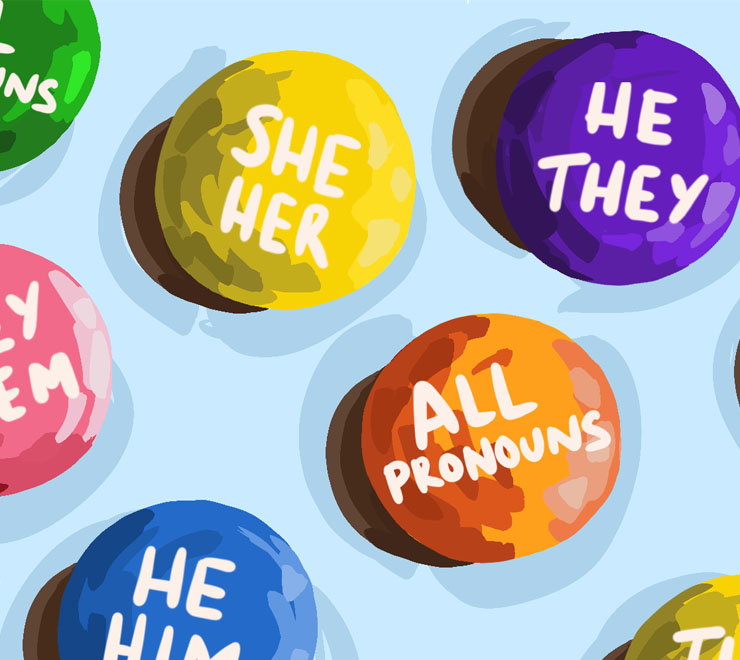For young people, growing up means figuring out who they are. A big part of that process may be determining their gender identity and gender expression. And that’s not always easy, especially when you start to realize who you are may not align with people’s expectations (e.g. society, friends, family, etc.)…
The course of living out who you truly are — especially against mainstream norms — can be challenging for folks at any age. Here, Kids Help Phone shares five tips — The course of living out who you truly are — especially against mainstream norms — can be challenging for folks at any age. Here, Kids Help Phone shares five tips — we’re calling them the “five Bes” — to help you support a young person in your life with exploring their gender identity and gender expression. As you read these tips, we hope you discover more ways to build authentic connections with the young person as they begin to make their way in the world.
5 ways to support a young person with identity and gender expression
Tip #1: Be open
A good baseline to set is to let the young person know your door is open. Create a safer / more approachable space for sharing by allowing them to choose the time and place for a conversation. Let them know that you’re available to talk (even if it sometimes seems like you’re not) and try to check in regularly. Being open also means being open-minded to anything the young person tells you. It’s OK to take time to pause and reflect or be curious to understand things more clearly. Try not to react to something until you have the full picture. Do your best to be supportive, listen and help them live out their identity in ways that make sense for them.
Tip #2: Be prepared
Before starting a conversation on identity and gender expression, it can be helpful to have the facts. Brush up on your knowledge of more inclusive terminology (it’s always evolving!). Kids Help Phone’s list of definitions can be a place to start. Communicate that you’re willing to learn more and break any old habits. During a conversation, listen to and use the words the young person is using to show you’re paying attention and learning. Follow their lead, since they’re the experts in their own lives, and things can change over time.
Tip #3: Be kind
Explain to the young person that there’s no pressure to determine their gender identity / gender expression. There’s also no rush to share anything with you or anyone else unless they want to / they’re ready. Show compassion by reminding them everyone is on a journey to feeling comfortable with who they are (including some older people, too). Demonstrate acceptance by sharing media (e.g. books, movies, music, etc.) from people of all identities, connecting them to those with similar lived experiences and getting involved with community groups that feel like a good fit.

What are personal pronouns, and why are they important?
What pronouns are and how to use them respectfully.
Tip #4: Be respectful
When talking to a young person, try to avoid making any judgments or jumping to conclusions. Try not to make assumptions or assign labels to them. Use the name(s) they identify with to help empower, validate and affirm their identity. While it can take time to adjust to a new, affirmed name, referring to someone by the name they used before coming out, transitioning, etc. (also known as “deadnaming”), can feel invalidating and hurtful. Using the correct personal pronoun(s) can also help to support and respect them.
If they haven’t shared aspects of their identity with you, you can gently prompt them and ask if there’s anything you can do to support them. You can say, “I like people to refer to me by he / him. Do you feel comfortable sharing your pronouns with me? It’s OK if you don’t know, I just want to make sure I’m not making any assumptions.”
Tip #5: Be brave
Everyone makes mistakes when talking to the young people in their lives. If you do make a mistake, it’s important to acknowledge and thank people for reminding you, correct yourself and move on. Keep in mind that some youth may find experiences and conversations about gender to be tough. Together, you can view resources and stories about things that are on your minds (e.g. hope, discrimination, intersectionality, Pride, transitioning, coming out, etc.) to learn more. Here are a few resources from organizations in Canada to check out:
- Send the Right Message (Planned Parenthood Toronto (PPT))
- Support Resources (The Canadian Centre for Gender and Sexual Diversity (CCGSD))
- Resources Around Me (Kids Help Phone)
It’s also essential to show solidarity with the young person. This means being supportive of their identity when they’re navigating the world (e.g. at school, in the community, with friends / family, etc.). Using their pronouns and name, gently correcting others (as needed) and joining in on activities they’re interested in while in public can all show allyship.
When supporting a young person in your life with their gender expression, it’s important to remember the “five Bes.” Let them know that you’ll try to be open, prepared, kind, respectful and brave as they experience and explore their identity. For more information and support, you can visit KidsHelpPhone.ca/Pride and Wellness Together Canada.








